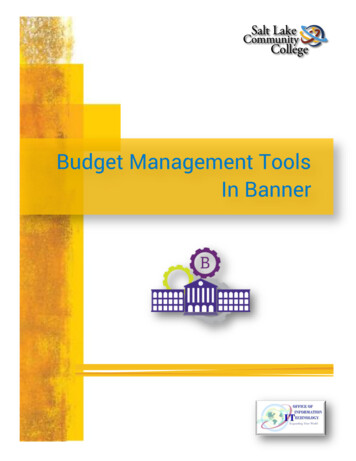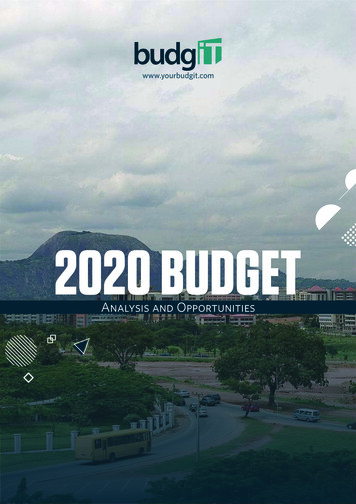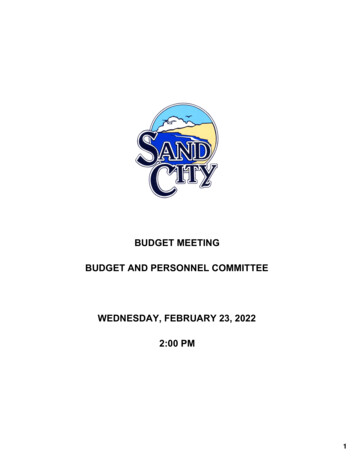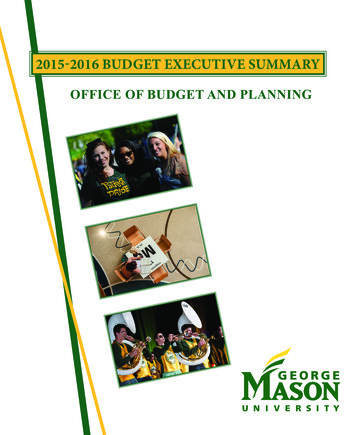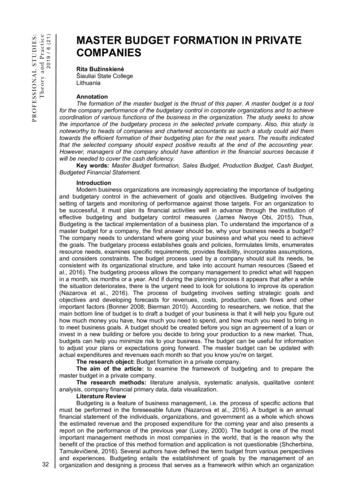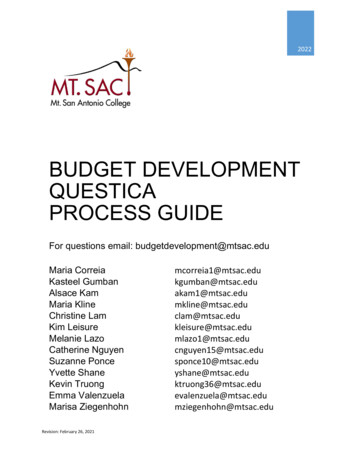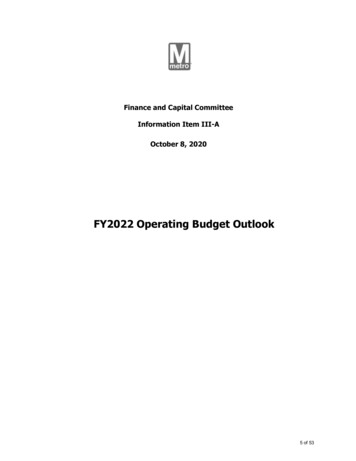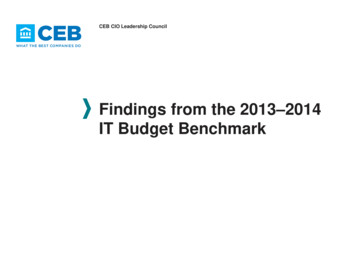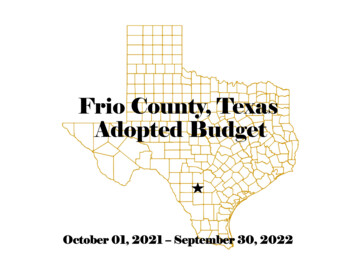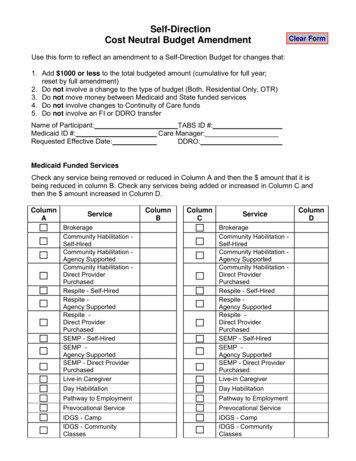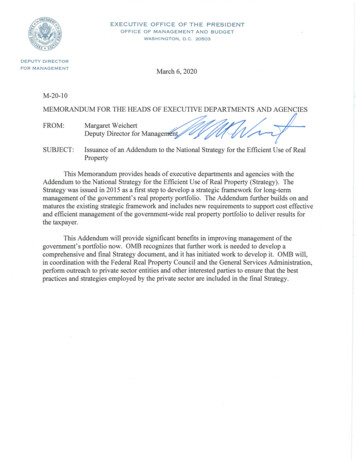
Transcription
EXECUTIVE OFFICE OF THE PRESIDENTOFFICE OF MANAGEMENT AND BUDGETWASHINGTON, D.C . 20503DEPUTY DIRECTORFOR MANAGEMENTMarch 6, 2020M-20-10MEMORANDUM FOR THE HEADS OF EXECUTIVE DEPARTMENTS AND AGENCIESFROM:Margaret WeichertDeputy Director for ManageSUBJECT:Issuance of an Addendum to the National Strategy for the Efficient Use of RealPropertyThis Memorandum provides heads of executive departments and agencies with theAddendum to the National Strategy for the Efficient Use of Real Property (Strategy). TheStrategy was issued in 2015 as a first step to develop a strategic framework for long-termmanagement of the government's real property portfolio. The Addendum further builds on andmatures the existing strategic framework and includes new requirements to support cost effectiveand efficient management of the government-wide real property portfolio to deliver results forthe taxpayer.This Addendum will provide significant benefits in improving management of thegovernment' s portfolio now. 0MB recognizes that further work is needed to develop acomprehensive and final Strategy document, and it has initiated work to develop it. 0MB will,in coordination with the Federal Real Property Council and the General Services Administration,perform outreach to private sector entities and other interested parties to ensure that the bestpractices and strategies employed by the private sector are included in the final Strategy.
Addendum to the National Strategy for RealPropertyOptimizing the Portfolio to Support theMission and Manage Costs
Addendum to the National StrategyIn accordance with the President's Management Agenda's (PMA) focus on mission, service, andstewardship, this Addendum to the Real Property National Strategy (Strategy) is being issued tomeet the following three objectives:1) Extend the duration of the existing Strategy and to more closely align it to the PMA;2) Outline specific actions that can be implemented under the direction of the Federal RealProperty Council (FRPC) to improve real property management and governance in theshort term, and;3) Outline the scope and content for a future publication of a more comprehensive NationalStrategy for Federal real property that not only takes into account the objectives outlinedin this Addendum, but considers leading real property management practices from theprivate sector, state and local governments, and other national governments.This Addendum extends the duration of the current Strategy until it can be replaced by acomprehensive new National Strategy. It provides a management framework, including specificactions, the Federal Real Property Council (FRPC) will lead now because they support agencies'ongoing effort to improve the mission effectiveness and cost efficiency of agency real propertyportfolios. While the framework and associated actions will provide immediate benefit, thisAddendum acknowledges that the current Strategy - even with the additions provided in thisdocument - will require expansion of scope and content to enable the Federal government tofully optimize its real property portfolio.The current Strategy is limited because it focuses solely on reducing office and warehouse space;it does not address optimizing the Federal portfolio as a whole, across and within agencies, formission effectiveness and cost efficiency. For example, it does not address the persistent dataquality issues that originate from a lack of government-wide data standards and businessprocesses, does not create a role for capital planning to prioritize limited investment funds, andalso does not provide a vision to link budget formulation to execution and program outcomes toensure funds are expended on the highest priority actions, among other improvement areas.Many of these issues are addressed by this Addendum but other issues require additionalresearch and analysis. Accordingly, this Addendum is intended to serve as an interim steptoward the issuance of a comprehensive real property National Strategy.Development of the comprehensive Strategy will require research on policies and practices usedby other organizations, which may include the private sector, State and local governments, aswell as governments in the Organization of Economic Cooperation and Development. Thestrategy will aim to learn from practices used to manage new construction, maintenance, repair,renovation and disposal of real property, including mechanisms to fund those activities.Additionally, the Strategy will require an assessment of how the federal government accounts forreal property assets on the balance sheet and makes other disclosures in the consolidatedfinancial statements of the U.S. government (including valuation, capitalization/recapitalization,depreciation, etc.) and compare those practices against other relevant accounting standardsemployed in the U.S. and by other national governments. It will also include an investigationinto leading practices and options for the federal government to manage and leverage its real2
property and land rights to maximize economic value to the American people and fuel economicdevelopment.This work will take some time to complete and distill into national policy. For that reason, theAddendum provides interim actions that the FRPC can implement in the short term to improveportfolio management.IntroductionFederal managers face multiple challenges precluding management excellence of the realproperty portfolio which includes both controllable and uncontrollable factors. For example, itcan be challenging for managers to secure appropriations necessary to adequately fund the fullreal property lifecycle, particularly when they lack a clearly articulated requirement andappropriate data to support the request. Agencies frequently focus on initial acquisition costs tothe detriment of other phases of the real property lifecycle such as planning, maintenance, repair,modernization, and disposal. The government's significant backlog of deferred maintenance andretention of unneeded property is partially due to lack of focus on later phases of the realproperty lifecycle. Additionally, Federal managers may require further legislative reforms toefficiently dispose of unneeded real property.Notwithstanding the long-standing challenges associated with funding and disposal processes,other major challenges can be mitigated by improving capital planning, standardizing businessprocesses and data, modernizing Information Technology (IT) to include expansion of sharedservices, and continued emphasis on disposal of excess property within existing authorities.Additional budget authorities and improved ability to dispose of excess property would furtherenable strategic allocation of resources to address critical mission capability gaps. The purposeof this Strategy is to provide a framework to address controllable challenges, improve agencies'capability to manage their real property portfolio, and document other budget and legislativereform options.Strategic.Vision for Federal Real PropertyThe Federal government needs a long-term vision and goal statement to help guide agenciestowards management excellence of the Federal real property portfolio. They are:Vision StatementPosition the Federal government to optimize its real property portfolio by actively addressingbudget and legislative barriers to good management practices, implementing business processand data standards, and building centralized and shared service solutions, consistent with thePMA.Goal StatementOptimize the Federal real property portfolio to support agency mission needs, demonstratestewardship of taxpayer resources, manage costs through implementation ofrobust capital and3
strategic planning, develop and use detailed budget and expenditure data, and prompt legislativereform.To "optimize" the real property portfolio is to ensure the Federal government has the right typeof property, in the right amount, at the right location, at the right cost, in the right condition, tosupport the diverse mission requirements of the agencies. There is not a "one size fits all"optimal configuration of real property. Accordingly, agencies will need to develop optimizationcriteria that best suit their unique mission requirements and that can also be used to measureprogress toward optimization.Challenges to Achieving the Government's Real Property Vision and GoalsThere are four high level challenges to optimizing the Federal government's real propertyportfolio.The first challenge is the significant constraints on available capital. This challenge is largelyoutside the control of Federal agencies because of their reliance on annual appropriations to fundreal property portfolio costs. Even with the best capital planning, agency leadership cannotsecure capital unless approved by Congress through the budget process. Real propertyappropriations, when competing with other mission requirements, have historically not beensufficient to perform necessary maintenance, repair, reinvestment, and disposal across theportfolio. This is evidenced by the backlog of repair needs (estimated in the Federal RealProperty Profile database to be 200 billion for buildings and structures), and the government'sreliance on commercial leases in cases where it would be more prudent to invest in government owned property.Insufficient operating capital directly contributes to the second high level challenge management of the government's legacy portfolio. The current portfolio is aged, with an averagebuilding age of 47 years, and it is too large and not configured to most efficiently supportmission requirements. Most of the government's buildings and structures were constructeddecades ago and they require modernization to support agency mission requirements. Many realproperty assets cannot easily be configured to meet modem work space requirements without alarge capital infusion, are not located where they can optimize mission delivery, or are publicfacing assets that are more heavily used now than originally intended due to population growthand demographic shifts. Funding has not been prioritized sufficiently to optimize the existingFederal real property portfolio. There is too little capital to transform the legacy portfolio bydisposing of unneeded property, building assets in more appropriate locations, consolidatingspace, modernizing old property that is still needed, and providing adequate maintenance andrepair funding to bring the existing property stock up to satisfactory condition. As a result, thegovernment must distribute its' limited capital over too many assets, precluding implementationof a concerted transformation strategy to optimize the portfolio.The third major challenge is management fragmentation of the real property portfolio intoisolated, agency-based communities of practice. Like many Federal mission support functions,real property is managed in a decentralized or agency specific manner without the benefit of awhole-of-government perspective. This results in inconsistency, fragmentation, and4
inefficiencies which inhibits appropriate inter-agency consolidation. Additionally, it has led to alack of standard business practices, capabilities, data definitions, and shared IT solutions. Due todifferences in historic practice and statutory authorities and requirements, agency-uniquemanagement practices have emerged over decades that make it difficult for agencies to agree oncommon practices to achieve economies of scale across the government. The lack of a common"language" across the portfolio limits the capacity of the Federal government to identifyredundant assets and capabilities, which leads to greater cost and inefficiencies.The fourth challenge is lack of integration among real property budget formulation, execution,and accounting for costs and performance within agencies. Current systems do not support thecollection and reporting of information needed for Federal managers to effectively track howfunding is used for specific real property elements such as maintenance, repair, renovation,operations, and disposal. Given this lack of transparency, senior agency decision makers cannoteffectively determine their funding requirements or whether their desired cost and performanceobjectives are being achieved. Often, agency leadership does not know how much is actuallybeing spent on real property because of the way cost data is collected and reported. New tools tolink strategic planning, budget formulation, and budget execution to accounting and performanceresults are necessary to improve funding transparency and better support decision making.The four major challenges require a government-wide mitigation strategies that includeimplementing capital planning, standardizing business processes and data, and proposinglegislative changes. Ultimately, alongside these strategies, addressing the legacy portfolio willrequire an infusion of capital to optimize the portfolio and meet mission requirements.There are five historic issues hindering the Federal government from making significant progresstowards a more optimizing the real property portfolio.Issue 1: Leadership EngagementLeadership engagement that sets a "tone at the top" is essential to achieve government-widetransformation goals. However, sufficient leadership attention has not been provided to managereal property as a strategic asset because real property is often not appreciated as an importantcomponent of mission success. The capital acquisition and disposal constraints placed on seniorFederal managers makes it daunting for them to prioritize significant improvements in the realproperty portfolio as it may be seen as a Sisyphean task. Consequently, the needs of the realproperty portfolio do not receive·sustained senior management attention during agency planningand budget formulation processes. For example, real property is frequently not included inagency strategic plans even though it houses their workforce, information technology, data,personal property, and inventories - all of which are usually identified as strategic assets -- thatenable mission delivery. Additionally, due to the lack of integration and transparency of budget,cost, and performance information, senior managers may miss efficiency opportunities.Issue 2: Multiyear Capital PlanningThe capital programming guide in 0MB Circular A-11 requires that agencies "must have acapital planning process that addresses project prioritization between new assets and5
maintenance of existing assets," yet many agencies have either not implemented a rigorousmultiyear capital planning process to allocate funding between the two, or they have notimplemented capital planning at all. As indicated previously, because the Federal governmenthistorically has not managed real property from a whole-of-government perspective, there hasnot been a common approach to capital planning. Capital planning within agencies has variedsignificantly and cannot be easily consolidated into an integrated government-widemethodology. Additionally, because many agencies do not link the capital planning to theirstrategic objectives, it makes it more difficult for agencies to make a strong business case forwhy additional capital is needed. To improve capital planning, on November 6, 2019, 0MBissued M-20-3, "Implementation of Agency-wide Real Property Capital Planning," which statesthat a core principle of this Administration's real property strategy is to ensure that agenciesconsistently implement sound capital planning practices to optimize the portfolio to costefficiently achieve the mission. This will ensure agencies identify, plan for, and allocateresources in the annual budget formulation process in order to eliminate gaps. Requirements setforth in this memo provide detailed guidance for agencies to implement the CapitalProgramming Guide in 0MB Circular A-11.Issue 3: Business Process and Data Standards and Shared IT SolutionsThe government's capability to manage its real property portfolio suffers from a lack of standardbusiness processes, data standards, and shared IT solutions. The objective of PMA CrossAgency Priority (CAP) Goal#5, "Sharing Quality Services" is to establish a strategicgovernment-wide framework to improve the effectiveness and cost efficiency of administrativeservices, such as real property management. The PMA framework supports development ofcommon business processes, data standards, and shared IT solutions within each administrativeservice area across the government to develop economies of scale that decrease costs andimprove management capability. The Federal Integrated Business Framework can serve as abasis to develop standard business processes, data standards and IT solutions to help align thereal property service area across agencies to gain economies of scale and enhance managementcapability. As those standards are implemented, Agencies can start looking for opportunities toconsolidate systems and move to shared services as the market develops for these tools.Issue 4: Alignment of Agency Internal Annual Budget ProcessesIn many cases, the agencies' annual budget formulation process focuses on the cost ofacquisition without adequate consideration given to out-year costs to operate, maintain, repair,·and dispose the property. By focusing heavily on the initial cost of acquisition, agencies do notalways fund costs associated with maintaining facilities in mission ready condition andmodernizing existing facilities. This has contributed to a growing backlog of deferredmaintenance and repair and has not made funding available to modernize existing facilities.Additional integration of planning, formulation, execution, accounting and reporting phases ofthe budget process is needed to optimize of the Federal real property portfolio. Agencies alsoneed to significantly improve internal coordination among lines of business (CFO, CIO, RealProperty, etc.) to ensure that all phases of the real property life cycle are addressed in the budgetformulation process.6
Issue 5: Federal Disposal ProcessThe current process under Title 40 of the U.S. Code for disposing of unneeded Federal realproperty is burdensome and it does not provide incentives for Federal managers to dispose ofproperty or to maximize the disposal value to taxpayers. Title 40 requires agencies to screenproperty disposals for at least 12 discrete public benefit conveyance requirements prior to sale.The average disposal timeframe is more than 12 months, during which time the governmentcontinues to carry the operating costs. Additionally, certain nonprofit institutions and State andlocal government can obtain Federal real property at no cost or a substantial discount if they usethe property for various types of public uses. These processes dissuade Federal managers fromdisposing of unneeded property. The Federal Assets Sale and Transfer Act (FASTA) processcan accelerate disposals through the sale of high value properties to speed disposal for a subset ofunneeded properties, but FASTA does not provide permanent relief from existing requirementsfor the rest of the portfolio. As lessons are learned from implementing the FASTA process,0MB and the FRPC will consider suggesting legislative proposals to reform the Federal disposalprocess and/or update the National Strategy.The Interim National Strategy FrameworkThis Addendum provides an interim strategic government-wide framework to improve theeffectiveness and efficiency of government-wide real property management. This frameworkexpands upon the executive branch's previous strategy document - the National Strategy for theEfficient Use of Real Property 2015-2020, which focused exclusively on the principles of"freeze," "measure," and "reduce" to eliminate office and warehouse space - by comprehensivelycataloguing relevant challenges and establishing strategies to address them. An expandedframework will help guide agencies as they work toward optimizing their portfolios for costefficiency and mission effectiveness. The previous National Strategy, issued in 2015,successfully reduced office and warehouse space, but its scope was too narrow to identify andaddress the persistent portfolio-wide challenges addressed here.The three strategies below, if fully implemented, will enable the Federal government managersto:1) Perform a comprehensive assessment of current and future mission capability gaps in theportfolio and the capital required to eliminate them;2) Establish a common, government-wide business environment where agencies adoptcommon business processes and standards and share IT and other tools and capabilitiesacross government to promote better management practices and eliminate redundancy, andprevent needless expenditure of resources; and,3) Identify legislative reforms that provide agency leadership with the authority needed toprioritize mission support and cost efficiency.Strategy 1 - Capital Planning: The implementation of a consistent and repeatable capitalplanning process government-wide will enable agencies to optimize their portfolio and support7
the strategic planning processes. 0MB Memorandum M-20-3 requires agencies to develop arisk-based five year capital planning process to identify current and future mission requirementgaps. Gap data will be used to develop capital plans to optimize each agency's real propertyportfolio which will likely span several five year plans due to funding constraints. The capitalplans will link to each landholding agency's strategic plan. Existing statutory requirements suchas FASTA and the Federal Property Management Reform Act (FRPMRA) will be utilized toaccelerate the elimination of current and future gaps identified in the capital plan. Actions one,two, and three below will be executed to support strategy 1.Action 1: Implement a common government-wide multi-year capital planning process, asdescribed in 0MB Memorandum M-20-3The memorandum's objective is to implement a government-wide capital planning requirementand to ensure that each agency follows a consistent, repeatable methodology for allocatingfinancial resources that prioritize the efficient use of taxpayer dollars and government assets.Applying consistent capital planning processes across the Federal landscape will identify andeliminate redundant capabilities and excess assets from the Government's portfolio and enablelong term, cost effective investments that support agencies' missions. The policy's desiredoutcome is an optimized portfolio where the agencies have the right type of property, in the rightamount, at the right location, in the right condition, at the right cost to support their mission. Atthe asset level, optimization factors to balance the portfolio include: size, cost effectiveness forasset location, mission capability, whether asset location supports mission attainment, whetherthe asset's capabilities could be better served by another asset, utilization, asset condition, andresilience and security, among others. OMB's Capital Programming Guide in 0MB Circular A11 will serve as the reference document for implementation of this requirement.Action 2: Include Real Property Management in Landholding Agencies' Strategic PlansReal property is an asset class that supports critical mission delivery functions - housing staff, ITsystems and data, providing space for service to the public, and supporting unique capabilitiessuch as medical care and customs inspection. As such, pursuant to 0MB M-20-03, it must berecognized as a strategic asset in the landholding agencies' strategic plans. Integrating realproperty management objectives, and addressing any gaps in the portfolio's ability to fullysupport the agencies' strategic plans, will increase focus on and improve management of an assetclass that has high fixed cost, limited management visibility, and limited potential for immediatetransformation due to capital constraints.Action 3: Establish a Biennial Real Property Portfolio Risk Report Highlighting Capital GapsAs an entity, the Federal government has not succeeded at assessing and communicatinggovernment-wide real property portfolio gaps, resource needs, and risks to taxpayers andCongress. The implementation of 0MB M-20-3 will provide the government with the data tobetter assess gaps, risks, and resource needs to enhance program transparency, and provideCongress with information to assist with its oversight, budget, and authorizing functions. Thereport will also help develop a partnership between the two branches of government tocollaboratively address the persistent financial and mission risks attendant to the government's8
real property portfolio. The FRPC, as the governing body, will help define and proposegovernment-wide strategies to focus the report on the portfolio's most pressing issues andrecommended solutions.Strategy 2 -Lifecycle Execution: Establish a common set of business process and datastandards across the property management life cycle that can be used to build shared IT solutionsto improve data quality, enhance transparency, and reduce costs, consistent with the PMA.Establishing standards will enable the implementation of tools and processes to help identifyredundant assets, highlight required capabilities, and help centralize real property managementwithin agencies to gain cost efficiencies. It will enable executive leadership to identifyopportunities to align business lines and consolidate real property among agencies.Action 4: Improve Management Decision-Making Capability through Budget Formulation andExecution TransparencyAs noted above, improving the transparency of agency level budget formulation and executionwill allow for improved decision making by linking budget inputs to outputs and outcomes, andby integrating all phases of the budget process.Action 5: Establish Business Process and Data Standards and Shared IT SolutionsThis action is governed by 0MB Memorandum M-19-16 Centralized Mission SupportCapabilities for the Federal Government. The primary objectives for this action are toimplement the Federal Integrated Business Framework to define government-wide programfunctions, activities, and capabilities required to implement the real property programconsistently, to develop standard data definitions, business processes, and information systemscapabilities, and to identify an agency to manage all standards and ensure their integrity overtime. The desired result is a common set of business process and data standards that enablesinteroperability across agencies that may lead to further opportunities to combine capabilities,eliminate redundant systems, and enable government-wide portfolio analysis to support costefficient operations. Standard business processes and data elements are essential building blocksfor leveraging technology to build shared solutions and to take advantage of advanced analytictools.Action 6: Establish and Publish Accountable Annual Performance Metrics for all AgenciesA collection of performance metrics is currently published on the performance.gov website usinggovernment-wide data. Under this action, agency specific annual performance metrics will bepublished on performance.gov to track the agencies' improvement on key measures such asspace utilization, portfolio condition, lease costs, and other metrics that the FRPC will specify.The objective is to enhance the program's transparency for all stakeholders so they can assessprogram improvement, provide agency management with a standard set of metrics to informtheir decisions, and modify the program culture to be more collaborative and open to evaluation.Strategy 3 -Root Cause Analysis: Identify the root cause(s) of existing real propertymanagement challenges and create a proposed legislative reform plan to help mitigate them. This9
proposal will complement existing proposals already laid out in the President's infrastructure andreform plans and previous budgets. The primary objective is to work with Congress to eliminatelegislative barriers that encourage the retention of unneeded properties, allow the repair backlogto continue to grow, and that limit the government's ability to fully fund large, transformativereal property actions. Actions seven and eight below will be executed to support Strategy 3.Action 7: Implement the Administration's Proposed Federal Capital Revolving FundFunding large real property projects is difficult in a budget era of tight spending limits, primarilybecause the full up-front appropriation scores against the discretionary spending caps asallocated across various congressional committees. This is problematic for large-dollar, one time expenses because they must compete with agency operating and program expenses, usuallyunsuccessfully. To mitigate this challenge, a capital financing fund needs to be established andstructured to function like a capital budget but operate within the traditional rules used for theFederal budget for civilian real property. Agencies would borrow money from the fund and payit back with their discretionary appropriations over a 15 year period. As a result, large realproperty projects would compete better with annual operating and programmatic expenses forlimited funding, and the government would be able to execute large projects to address missionrequirements, modernize critical facilities and reduce its reliance on leasing. For more details,see the President's Legislative Outline for Rebuilding Infrastructure in America where thisproposal is discussed in more detail.Action 8: Propose Legislative Changes to Mitigate ChallengesThe intractable issues identified in this document- the disposal process, the limits on capital(particularly for very large projects), and addressing the government's legacy portfolio - requirelegislative reform to mitigate. Additional reforms, once identified, can significantly improve theprogram's quotidian operations and reduce the government's cost and administrative
WASHINGTON, D.C. 20503 . DEPUTY DIRECTOR . FOR MANAGEMENT . March 6, 2020 . M-20-10 . MEMORANDUM FOR THE HEADS OF EXECUTIVE DEPARTMENTS AND AGENCIES . FROM: Margaret Weichert Deputy Director for .
